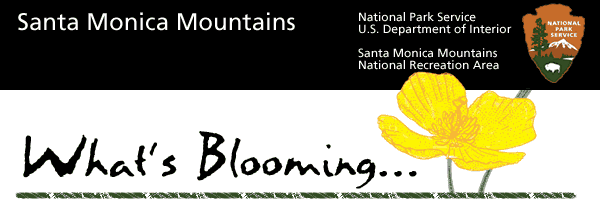
|
Available Sites |
|
Revised: 9/15/04 |
|
Rocky Oaks |
9/8/04 |
|
See the photo gallery of
What’s Blooming at: http://www.nps.gov/samo/bloom/bloom.htm
Flowers are still blooming in spite of mid
summer heat and little rainfall this year. Try
some of the walks listed below. Early morning or late days are coolest.
|
Rocky Oaks |
|
Date
Observed:9/08/04 |
|
Rocky is
another unit with a variety of habitats. The pond is a major feature because
of the persistent moisture. Consequently near the pond we see flowers not
present in some other locations or flowers that have elsewhere quit blooming.
In the low areas we can see Yellow Water Weed, stands of Water Smartweed,
Cattail, Wild Heliotrope, Lowland Cudweed, a few scattered Narrow-leaved Milkweed, and some Purple Nightshade still in bloom. |
||
|
Naturalist's
rating: Fair |
||
|
Rancho Sierra Vista |
|
Date
Observed: 9/06/2004 |
|
Coming to a
garden is not the same as finding wildflowers in their natural locations, but
those who want to see blooming wildflowers will enjoy the small native plant garden
at Rancho Sierra Vista/Satwiwa. |
||
|
Naturalist's
rating: Fair |
||
|
Circle X Ranch |
Grotto Trail |
Date
Observed:9/03/04 |
|
We are pretty
much down to the summer bloomers now, many of which will continue to bloom
for some time. At the dry top end of the trail you can find Milk-asters (both
Tejon and Twiggy Wreath Plant) and the similar Cliff-Aster. The delightful
purple and gold Woolly Aster is everywhere as are the Sawtooth Goldenbush.
Finally, Both Hoary and California Fuchsia add a striking red to this
bone-dry area. Black Mustard,
California Buckwheat, Ashyleaf Buckwheat, Felt-leaf Everlasting, Telegraph
Weed, California Sagebrush, and Morning Glory. |
||
|
Naturalist's
rating: Fair |
||
|
Point Mugu State Park
|
Ray Miller Trail |
Date
Observed:8/19/04 |
|
This
first link of the Backbone Trail starts just off Pacific Coast Highway. The
trail was in good condition, the cool ocean breeze was welcoming and the view
of the Pacific Ocean (with cavorting dolphins) was grand, but the blooms were
poor. The parched condition of the chaparral was disheartening and the flower
sightings were limited to 11 species. The yellow blooms included sweet
fennel, saw-toothed golden bush, slender tarweed, and hedge mustard. Several
hoary fuchsias were the only reds and the pinks seen were wand buckwheat, and
ashy-leaved buckwheat. Contributing to the violet tints were a few bush
mallow, wooly aster, and wand chicory. Other sightings of note were a few
mountain mahogany feathery seed pappi. (RWM) |
||
|
Naturalist's
rating: Poor |
||
|
Contact Information: Santa Monica Mountains National
Recreation Area 401 West Hillcrest Drive Ph. 805-370-2301 web. www.nps.gov/samo |
Thank you for your contributions: Robert W. Maughmer |
If you would like to contribute
to the wildflower report: e-mail: sheila_braden@nps.gov |
|
|
||